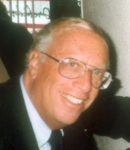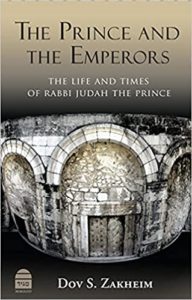By Rabbi Dr. Israel Drazin

 BOCA RATON, Florida — Using many sources, including hundreds of anecdotes, former US Deputy Under Secretary of Defense (1985-1987) and Under Secretary of Defense (2001-2004) Rabbi Dr. Dov S. Zakheim, author of Nehemiah: Statesman and Sage (Maggid Books, 2016), gives us a very informative and riveting, easy to read biography of one of the most important figures of ancient Jewry, Rabbi Judah the Prince (135-217), also called Rebbe, “Teacher.” He was the man who had Judaism’s Oral Law put into writing, called the Mishna, which became the basis of the Talmud.
BOCA RATON, Florida — Using many sources, including hundreds of anecdotes, former US Deputy Under Secretary of Defense (1985-1987) and Under Secretary of Defense (2001-2004) Rabbi Dr. Dov S. Zakheim, author of Nehemiah: Statesman and Sage (Maggid Books, 2016), gives us a very informative and riveting, easy to read biography of one of the most important figures of ancient Jewry, Rabbi Judah the Prince (135-217), also called Rebbe, “Teacher.” He was the man who had Judaism’s Oral Law put into writing, called the Mishna, which became the basis of the Talmud.
Maimonides (1138-1204) tells us in his commentary on Mishna that Judah collected all the oral laws, explications, and interpretations that had been passed down the generations from Moses onward and synthesized them all into the Mishna. Maimonides praised him: “He was unique in his generation and in his time, a man who embodied all that was beloved and [possessed] all the right character traits so that he merited that his contemporaries would refer to him as our Holy Rabbi…. He was the essence of wisdom and greatness.”
Judah was based in Judea, the land of his patrimony, which once was ruled by the House of David, from which he claimed descent. As leader of the Jewish community, he was a ruler in his own right; and was recognized as a prince [Nasi in Hebrew] both by his own people and by the Romans. In fact, the Talmud records over 50 conversations that Judah had with the Emperor of Rome, and midrashic literature over 50 more. While ultra-Orthodox Jews accept the stories about Judah at face value, and many academic scholars doubt their authenticity, Zakheim considers these stories as having a germ of truth. He identifies the Antoninus mentioned in the ancient sources as Emperor Septimius Severus and his son Caracalla about whom the Christian leader Jerome wrote that they “esteemed the Jews very highly.” The two co-ruled Rome from 198 to 211, and Caracalla ruled alone for an additional six years, dying the same year as the Nasi. Zakheim’s book is titled The Prince and the Emperors, and he tells us much about the lives of the three of them.
Judah was not the highest ranking Jewish leader during his lifetime. The Resh Galuta, the exilarch, who led the Babylonian Jewish community with the king’s blessing, as a patrilineal descendant of King David, could claim more blue blood than Rebbe whose Davidic ancestry was matrilineal. If the exilarch came to Judea, protocol would have demanded that Rebbe defer to him. But Rebbe, not the exilarch, was one of the greatest leaders Jewry has ever known. The exilarch produced no work comparable to the Mishna.
Judah was brilliant. He was educated in the Greek fashion. He was a first-rate jurist, a talented administrator, an accomplished statesman. He reversed the hostility between Jews and the Romans and brought peace to Judea. He was very rich. He was accompanied by armed retainers when he went out, like the Roman emperors. He was, as Zakheim shows, a man who thought outside the box. Like upper class Romans, he spoke Greek as well as Hebrew. He was open-minded. He conceded that at times the non-Jews were more knowledgeable about science than his own colleagues.
Zakheim tells us many interesting things about Judah’s ancestors, such as Hillel and Judah’s dad Simon who as Nasi dressed like the non-Jewish Romans, unlike many ultra-Orthodox Jews today who wear clothes like their eighteenth century forbearers. He describes Judah’s colleagues, students, and children. He informs us regarding Judah’s educational philosophy, “Train the youth according to his way” rather than forcing the student to engage in matters that are of little interest to them. He respected his students, and said, “I have learned much Torah from my teachers, and even more from my colleagues, but from my students, more than all the rest.” He saw enormous value in secular education. Contrary to some of his fellow rabbis, he took a lenient approach to conversion, like his ancestor Hillel, and unlike the Chief Rabbinate in Israel today. The Talmud, Gittin 59a, states that “Between Moses and Rebbe we do not find an individual who was supreme both in Torah and in worldly affairs.”
Zakheim also tells us many things concerning Judah’s Mishna and his impact on Jewish law, and gives us samplings of his legal rulings not all of which were accepted by fellow rabbis such as his view that the recital of the Shema – “Hear Israel, the Lord is our God, the Lord is One” – is so significant, and Hebrew so important, and vocalizing ideas is impactful, that one should recite the Shema in Hebrew out loud. He downplayed the military aspects of Hanukkah and focused on the miracle of the oil. Focusing on peace, he also attempted unsuccessfully to abolish Tisha B’Av which commemorated the destruction of the two temples.
There are many complementary legends about the events during Judah’s death in 217, even miracles, but it is true that “incense was burned after he died as it is for royalty.” With his passing, the high point of positive Jewish-Roman relations came to an end, with a brief six year turn for the better only from 355 to 361 during the reign of the emperor Julian the Apostate. And although he died, his legacy, the Mishna, lives on. He is remembered, unlike the emperors with whom he spoke, whose names few know.
*
Rabbi Dr. Israel Drazin is a retired brigadier general in the U.S. Army chaplain corps and has authored more than 50 books.